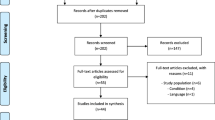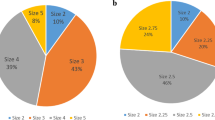Abstract
The aim of this Danish multicenter trial was to compare the proportion of women with lower urinary tract symptoms after total abdominal hysterectomy (TAH) and subtotal abdominal hysterectomy (SAH) for benign uterine disorders. A total of 319 women were randomized to TAH (n=158) or SAH (n=161). Women were followed up for 1 year by strict data collection procedures, including postal questionnaires. Results were analyzed by intention-to-treat analyses. Urinary incontinence was found less often among TAH women than among SAH women. This was due to a larger reduction of the number of women with stress and urinary incontinence in the TAH group. No other differences were found between the two operation methods. The number of women with urinary incontinence and frequency was reduced from study entry for follow-up, while double/triple voiding was increased. Incontinent women had significantly lower quality of life scores than continent women.

Similar content being viewed by others
References
Gimbel H, Settnes A, Tabor A (2001) Hysterectomy on benign indication in Denmark 1988–1998. A register based trend analysis. Acta Obstet Gynecol Scand 80:267–272
Vuorma S, Terperi J, Hurskainen R, Keskimäki I, Kujansuu E (1998) Hysterectomy trends in Finland in 1987–1995—a register based analysis. Acta Obstet Gynecol Scand 77:770–776
Sills ES, Saini J, Applegate MS, McGee M III, Gretz HF III (1998) Supracervical and total abdominal hysterectomy trends in New York State: 1990–1996. J Urban Health 75:903–910
Bridgman SA, Dunn KM (2000) Has endometrial ablation replaced hysterectomy for the treatment of dysfunctional uterine bleeding? National figures. Br J Obstet Gynaecol 107:531–534
Sommer P, Bauer T, Nielsen KK, Kristensen ES, Hermann GG, Steven K et al (1990) Voiding patterns and prevalence of incontinence in women: a questionnaire survey. Br J Urol 66:12–15
Samuelson E, Victor A, Tibblin G (1997) A population study of urinary incontinence and nocturia among women aged 20–59 years: prevalence, well-being and wish for treatment. Acta Obstet Gynecol Scand 76:74–80
Simeonova Z, Milsom I, Kullendorff M, Molander U, Bengtsson C (1999) The prevalence of urinary incontinence and its influence on the quality of life in women from an urban Swedish population. Acta Obstet Gynecol Scand 78:546–551
Milson I (2000) The prevalence of urinary incontinence. Acta Obstet Gynecol Scand 79:1056–1059
Milsom I, Ekelund P, Molander U, Arvidsson L, Areskoug B (1993) The influence of age, parity, oral contraception, hysterectomy and menopause on the prevalence of urinary incontinence in women. J Urol 149:1459–1462
Thom DH, van den Eeden SK, Brown JS (1997) Evaluation of parturition and other reproductive variables as risk factors for urinary incontinence in later life. Obstet Gynecol 90:983–939
Møller LA, Lose G, Jørgensen T (2000) Risk factors for lower urinary tract symptoms in women 40 to 60 years of age. Obstet Gynecol 96:446–451
Mommsen S, Foldspang A (1994) Body mass index and adult female urinary incontinence. World J Urol 12:319–322
Brown JS, Seeley DG, Fong J, Black DM, Ensrud KE, Grady D (1996) Urinary incontinence in older women: who is at risk? Study of Osteoporotic Fractures Research Group. Obstet Gynecol 87:715–721
Graham CA, Mallett VT (2001) Race as a predictor of urinary incontinence and pelvic organ prolapse. Am J Obstet Gynecol 185:116–120
Brown JS, Sawaya G, Thorn DH, Grady D (2000) Hysterectomy and urinary incontinence: a systematic review. Lancet 356:535–539
Gimbel H, Zobbe V, Andersen BM, Filtenborg T, Gluud C, Tabor A (2003) Danish Hysterectomy Group. Randomised controlled trial of total versus subtotal hysterectomy with one-year follow up results. BJOG 110:1088–1098
Rannestad T, Eikeland O-J, Helland H, Qvarnström U (2001) The quality of life in women suffering from gynecological disorders is improved by means of hysterectomy: absolute and relative differences between pre- and postoperative measures. Acta Obstet Gynecol Scand 80:46–51
Grimby A, Milsom I, Molander U, Wiklund I, Ekelund P (1993) The influence of urinary incontinence on the quality of life in elderly women. Age Ageing 22:82–89
Robinson D, Pearce KF, Preisser JS, Dugan E, Suggs PK, Cohen SJ (1998) Relationship between patient reports of urinary incontinence and quality of life measures. Obstet Gynecol 91:224–228
Lalos O, Bjerle P (1986) Bladder wall mechanics and micturition before and after subtotal and total hysterectomy. Eur J Obstet Gynecol Reprod Biol 21:143–150
Thakar R, Manyonda I, Stanton S, Ayers S, Clarkson P, Robinson G (2002) Outcomes after total versus subtotal abdominal hysterectomy. N Engl J Med 347:1318–1325
Learman LA, Summitt RL Jr, Varner RE, McNeeley SG, Goodman-Gruen D, Richter HE, Lin F, Showstack J, Ireland CC, Vittinghoff E, Hulley SB, Washington AE et al (2003) A randomized comparison of total or supracervical hysterectomy: surgical complications and clinical outcomes. Obstet Gynecol 102:453–462
Lauridsen L, Jensen VC (1961) Total contra subtotal hysterektomi [Total contra subtotal hysterectomy]. Ugeskr Læger 123:298–307
Iosif CS, Bekassy Z, Rydhström H (1988) Prevalence of urinary incontinence in middle-aged women. Int J Gynaecol Obstet 26:255–259
Kilkku P (1985) Supravaginal uterine amputation versus hysterectomy with reference to subjective bladder symptoms and incontinence. Acta Obstet Gynecol Scand 64:375–379
Kilkku P, Hirvonen T, Gronroos M (1981) Supra-vaginal uterine amputation vs. abdominal hysterectomy: the effect on urinary symptoms with special reference to pollakisuria, nocturia and dysuria. Maturitas 3:197–204
Ruoss CF (1995) Supravaginal hysterectomy—a less invasive procedure. J Obstet Gynecol 15:406–409
Kujansuu E, Teisala K, Punnonen R (1989) Urethral closure function after total and subtotal hysterectomy measured by urethrocystometry. Gynecol Obstet Invest 27:105–106
Gimbel H, Zobbe V, Ottesen B, Tabor A (2002) Randomized clinical trial of total versus subtotal hysterectomy: validation of the trial questionnaire. Acta Obstet Gynecol Scand 81:968–974
Jackson S, Donovan J, Brookes S, Eckford S, Swithinbank L, Abrams P (1996) The Bristol Female Lower Urinary Tract Symptoms questionnaire: development and psychometric testing. Br J Urol 77:805–812
Bernstein I, Sejr T, Abel I, Andersen JT, Fischer-Rasmussen W, Klarskov P, Lose G, Madsen H, Mortensen S, Tetzschner T, Walter S (1996) Assessment of lower urinary tract symptoms in women by a self-administered questionnaire: test-retest reliability. Int Urogynecol J Pelvic Floor Dysfunct 7:37–47
Ryhammer AM, Laurberg S, Djurhuus JC, Hermann AP (1998) No relationship between subjective assessment of urinary incontinence and pad test weight gain in a random population sample of menopausal women. J Urol 159:800–803
Simons AM, Yoong WC, Buckland S, Moore KH (2001) Inadequate repeatability of the one-hour pad-test: the need for a new incontinence outcome measure. Br J Obstet Gynaecol 108:315–319
Homma Y, Ando T, Yoshida M, Kageyama S, Takei M, Kimto K, Ishizuka O, Gotoh M, Hashimoto T (2002) Voiding and incontinence frequencies: variability of diary data and required diary length. Neurourol Urodyn 23:204–209
Summit RL, Bent AE (1996) Genuine stress incontinence: an overview. In: Ostergaard DR, Bent AE (eds) Urogynecology and urodynamics. Theory and practice. Williams and Wilkins, Baltimore, pp 493–505
Mouritsen L, Rasmussen A (1993) Bladder neck mobility evaluated by vaginal ultrasonography. Br J Urol 7:166–171
Käser O, Iklé FA, Hirsch HA (1985) Atlas of gynecological surgery. Georg Thieme Verlag, Stuttgart, p 7.4
Demirci F, Ozden S, Alpay Z, Demirci ET (1999) The effect of abdominal hysterectomy on bladder neck and urinary incontinence. Aust N Z J Obstet Gynecol 39:239–242
Penttinen J, Lindholm EL, Kaar K, Kauppila A (1989) Successful colposuspension in stress incontinence reduces bladder neck mobility and increases pressure transmission to the urethra. Arch Gynecol Obstet 244:233–238
Mouritsen L (2001) Effect of vaginal devices on bladder neck mobility in stress incontinent women. Acta Obstet Gynecol Scand 80:428
Haylen BT, Law MG, Frazer M, Schulz S (1999) Urine flow rates and residual urine volumes in urogynecology patients. Int Urogynecol J Pelvic Floor Dysfunct 10:378–383
Acknowledgments
We wish to thank our colleagues from the Department of Obstetrics and Gynecology, Hvidovre Hospital, as well as Dorte Nielsen, MD, Head of Department, Department of Obstetrics and Gynecology, Frederiksberg Hospital, and Prof. Gunnar Lose, MD, DrSci, for discussions and their critical comments to the interpretation of the results. Further, we wish to thank Jakob Hjort for his skilled generation of the allocation sequence and excellent management of the randomization procedure and program. We wish to thank Peter Olesen, MD, Kirsten Rylev Larsen, MD, Marlene Mohr, MD, and Namreen Chouhan, MD, for assistance regarding recruitment of patients. We wish to thank Lars Schouenborg, MD, and Lisbeth Nilas, MD, DrSci, for the categorization of the postoperative complications. Finally, we wish to thank Jan Blaakær, MD, DrSci, and Jørgen Hilden, MD, for their work in the Data Monitoring and Safety Committee. This study has been supported by grants from the Health Insurance Fond, the Copenhagen Hospital Corporation’s Medical Research Council, the Danish Medical Research Council, the Foundation Supporting Medical Research in Roskilde, Vestsjællands, Storstrøms, Frederiksborg and Bornholms Counties, the Højmosegård Foundation, Organon’s Foundation supporting Gynecological Research, the Roskilde County Hospital, the Copenhagen Trial Unit, and the Research Foundation at the Department of Gynecology and Obstetrics, H:S Hvidovre Hospital.
Author information
Authors and Affiliations
Corresponding author
Rights and permissions
About this article
Cite this article
Gimbel, H., Zobbe, V., Andersen, B.M. et al. Lower urinary tract symptoms after total and subtotal hysterectomy: results of a randomized controlled trial. Int Urogynecol J 16, 257–262 (2005). https://doi.org/10.1007/s00192-005-1291-8
Received:
Accepted:
Published:
Issue Date:
DOI: https://doi.org/10.1007/s00192-005-1291-8




